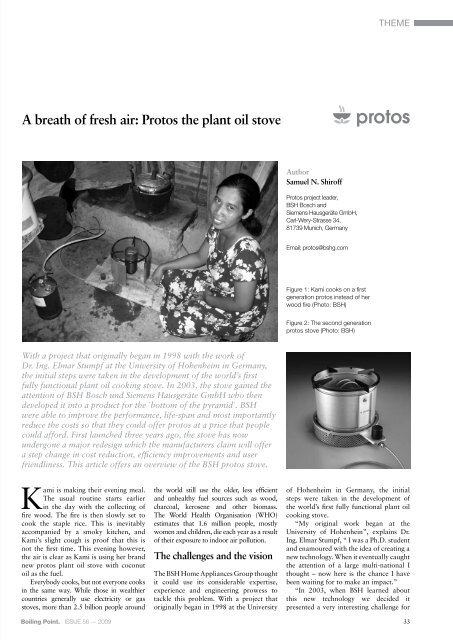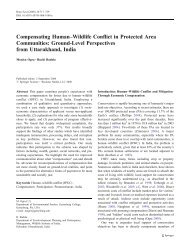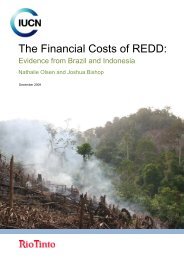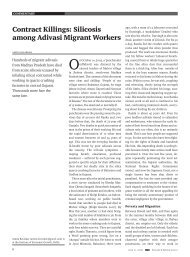Protos the plant oil stove.pdf - India Environment Portal
Protos the plant oil stove.pdf - India Environment Portal
Protos the plant oil stove.pdf - India Environment Portal
You also want an ePaper? Increase the reach of your titles
YUMPU automatically turns print PDFs into web optimized ePapers that Google loves.
A breath of fresh air: <strong>Protos</strong> <strong>the</strong> <strong>plant</strong> <strong>oil</strong> <strong>stove</strong><br />
With a project that originally began in 1998 with <strong>the</strong> work of<br />
Dr. Ing. Elmar Stumpf at <strong>the</strong> University of Hohenheim in Germany,<br />
<strong>the</strong> initial steps were taken in <strong>the</strong> development of <strong>the</strong> world’s first<br />
fully functional <strong>plant</strong> <strong>oil</strong> cooking <strong>stove</strong>. In 2003, <strong>the</strong> <strong>stove</strong> gained <strong>the</strong><br />
attention of BSH Bosch und Siemens Hausgeräte GmbH who <strong>the</strong>n<br />
developed it into a product for <strong>the</strong> `bottom of <strong>the</strong> pyramid`. BSH<br />
were able to improve <strong>the</strong> performance, life-span and most importantly<br />
reduce <strong>the</strong> costs so that <strong>the</strong>y could offer protos at a price that people<br />
could afford. First launched three years ago, <strong>the</strong> <strong>stove</strong> has now<br />
undergone a major redesign which <strong>the</strong> manufacturers claim will offer<br />
a step change in cost reduction, efficiency improvements and user<br />
friendliness. This article offers an overview of <strong>the</strong> BSH protos <strong>stove</strong>.<br />
Kami is making <strong>the</strong>ir evening meal.<br />
The usual routine starts earlier<br />
in <strong>the</strong> day with <strong>the</strong> collecting of<br />
fire wood. The fire is <strong>the</strong>n slowly set to<br />
cook <strong>the</strong> staple rice. This is inevitably<br />
accompanied by a smoky kitchen, and<br />
Kami’s slight cough is proof that this is<br />
not <strong>the</strong> first time. This evening however,<br />
<strong>the</strong> air is clear as Kami is using her brand<br />
new protos <strong>plant</strong> <strong>oil</strong> <strong>stove</strong> with coconut<br />
<strong>oil</strong> as <strong>the</strong> fuel.<br />
Everybody cooks, but not everyone cooks<br />
in <strong>the</strong> same way. While those in wealthier<br />
countries generally use electricity or gas<br />
<strong>stove</strong>s, more than 2.5 billion people around<br />
B<strong>oil</strong>ing Point. issue 56 — 2009<br />
<strong>the</strong> world still use <strong>the</strong> older, less efficient<br />
and unhealthy fuel sources such as wood,<br />
charcoal, kerosene and o<strong>the</strong>r biomass.<br />
The World Health Organisation (WHO)<br />
estimates that 1.6 million people, mostly<br />
women and children, die each year as a result<br />
of <strong>the</strong>ir exposure to indoor air pollution.<br />
The challenges and <strong>the</strong> vision<br />
The BSH Home Appliances Group thought<br />
it could use its considerable expertise,<br />
experience and engineering prowess to<br />
tackle this problem. With a project that<br />
originally began in 1998 at <strong>the</strong> University<br />
Author<br />
Samuel N. Shiroff<br />
<strong>Protos</strong> project leader,<br />
BsH Bosch and<br />
siemens Hausgeräte GmbH,<br />
Carl-Wery-strasse 34,<br />
81739 Munich, Germany<br />
email: protos@bshg.com<br />
Figure 1: Kami cooks on a first<br />
generation protos instead of her<br />
wood fire (Photo: BsH)<br />
Figure 2: The second generation<br />
protos <strong>stove</strong> (Photo: BsH)<br />
THEME<br />
of Hohenheim in Germany, <strong>the</strong> initial<br />
steps were taken in <strong>the</strong> development of<br />
<strong>the</strong> world’s first fully functional <strong>plant</strong> <strong>oil</strong><br />
cooking <strong>stove</strong>.<br />
“My original work began at <strong>the</strong><br />
University of Hohenhein”, explains Dr.<br />
Ing. Elmar Stumpf, “ I was a Ph.D. student<br />
and enamoured with <strong>the</strong> idea of creating a<br />
new technology. When it eventually caught<br />
<strong>the</strong> attention of a large multi-national I<br />
thought – now here is <strong>the</strong> chance I have<br />
been waiting for to make an impact.”<br />
“In 2003, when BSH learned about<br />
this new technology we decided it<br />
presented a very interesting challenge for<br />
33
THEME<br />
Figure 3: Cooking fuel pyramid -<br />
Who and where are <strong>the</strong> users?<br />
us”, explains <strong>the</strong> Senior Vice President of<br />
sales for emerging markets Dr. h.c. Dirk<br />
Hoffmann, “concurrently, we believed<br />
that if we could develop a product for <strong>the</strong><br />
`bottom of <strong>the</strong> pyramid` it would provide<br />
BSH some unique insights into a market<br />
that we do not currently serve with our<br />
conventional products.”<br />
Dr. Stumpf was brought on board<br />
to make <strong>the</strong> next developments in <strong>the</strong><br />
technology. “We had achieved some real<br />
advances in Hohenheim, but <strong>the</strong> product<br />
was not ready for a mass market. With<br />
<strong>the</strong> resources and <strong>the</strong> teamwork at BSH<br />
we were able to improve <strong>the</strong> performance,<br />
life-span and most importantly reduce <strong>the</strong><br />
costs so that we could offer protos at a<br />
price that people could afford.<br />
Plant <strong>oil</strong>s often have different levels of<br />
viscosity and BSH was determined to make<br />
a cooker that would not only burn all<br />
types of <strong>oil</strong>, but would also do so without<br />
requiring <strong>the</strong>m to be refined. “People<br />
in rural settings may have <strong>the</strong> ability to<br />
press <strong>the</strong>ir own <strong>oil</strong>, but <strong>the</strong>y don’t have<br />
<strong>the</strong> infrastructure to refine it,” explains<br />
Dr. Stumpf, “our challenge was to make a<br />
cooker that would burn <strong>oil</strong> that had been<br />
filtered in a simple manner and required no<br />
refining. This isn’t <strong>oil</strong> you buy in <strong>the</strong> store.<br />
It is a very simple and low cost fuel.”<br />
By <strong>the</strong> time BSH publicly launched<br />
<strong>Protos</strong> in April of 2006 <strong>the</strong> <strong>stove</strong> had<br />
already gone through many different<br />
technical and design changes. However,<br />
a last change was in store. Although <strong>the</strong><br />
protos team had already reduced <strong>the</strong><br />
cost of production by over 50% and had<br />
dramatically increased <strong>the</strong> efficiency of<br />
<strong>the</strong> <strong>stove</strong>, a series of experiments came<br />
toge<strong>the</strong>r to allow for a technological leap<br />
that created a new protos generation.<br />
The new cooker has a revised design<br />
and brings with it a 40% cost reduction,<br />
30% efficiency increase and a dramatic<br />
improvement in user friendliness with<br />
easier cleaning and quieter operation. “The<br />
only downside,” explains Samuel Shiroff,<br />
protos project leader, “is that it caused a<br />
disruption in our production schedule and<br />
plans for large-scale market introduction.<br />
Although waiting for a new generation<br />
meant a 12-month delay, we decided<br />
that <strong>the</strong> purchase cost and especially <strong>the</strong><br />
34<br />
reduced operating cost were such strong<br />
arguments for poorer customers that it<br />
would be inappropriate to sell <strong>the</strong>m <strong>the</strong><br />
first generation when <strong>the</strong> second was so<br />
much better.”<br />
The fuel, <strong>the</strong> customers<br />
and <strong>the</strong> carbon<br />
<strong>Protos</strong> presented some brand new challenge<br />
to BSH. Dr. Hoffmann explains, “although<br />
we have always made adjustments in design,<br />
size and o<strong>the</strong>r changes needed for different<br />
market specifications of electricity or gas,<br />
we never before put much thought into<br />
<strong>the</strong> source of <strong>the</strong> fuel. With <strong>plant</strong> <strong>oil</strong> this<br />
is different.” BSH makes a clear policy of<br />
stating that it will not introduce protos in<br />
markets where it cannot be assured of <strong>the</strong><br />
sustainability of <strong>plant</strong> <strong>oil</strong>: in terms of both<br />
environmental and social factors. Hoffmann<br />
continues, “A second huge challenge is<br />
serving a different kind of customer. BSH<br />
primarily sells high-end goods to customers<br />
for whom price is not <strong>the</strong> sole concern. We<br />
realized that protos’ customers might not<br />
be able to pay even <strong>the</strong> cost of production,<br />
but like all customers, <strong>the</strong>y want a userfriendly,<br />
well designed and durable product.<br />
We always knew that achieving this and<br />
economic sustainability – that is not losing<br />
money on every product – was going to<br />
require some innovative business models.”<br />
As is true with any product, identifying<br />
<strong>the</strong> correct market segment to target is<br />
essential (see Fig. 3). Poor households<br />
have a lot in common but <strong>the</strong>y are by no<br />
means a homogenous group. A <strong>plant</strong> <strong>oil</strong><br />
<strong>stove</strong> requires a liquid fuel. In addition,<br />
research conducted by BSH indicated that<br />
in most circumstances only families that<br />
were already using a monetized fuel (i.e.<br />
paying for it) would be willing to switch<br />
to protos. Moreover, although <strong>the</strong> cost<br />
of <strong>the</strong> <strong>stove</strong> itself must be reasonable, <strong>the</strong><br />
most important cost criteria would be on a<br />
cost per meal basis. Using <strong>plant</strong> <strong>oil</strong> as a fuel<br />
source in protos needed to be at a lower cost<br />
than <strong>the</strong> current alternatives. Concurrently,<br />
<strong>plant</strong> <strong>oil</strong> had <strong>the</strong> large advantage over<br />
liquefied petroleum gas (LPG) in so far as<br />
that <strong>plant</strong> <strong>oil</strong> can be purchased in small<br />
quantities whereas LPG often presented<br />
cash flow problems for poor families.<br />
Once <strong>the</strong> correct market had been<br />
identified, tackling <strong>the</strong> challenge of <strong>the</strong><br />
purchase cost of <strong>the</strong> <strong>stove</strong> required a<br />
different perspective. BSH has focused on<br />
truly understanding how protos provides a<br />
variety of service. Shiroff clarifies, “protos<br />
is a <strong>stove</strong>, but people don’t really want a<br />
<strong>stove</strong>, <strong>the</strong>y want warm food – that is <strong>the</strong><br />
service a <strong>stove</strong> provides. In addition we<br />
recognized that protos provides some<br />
additional services; in terms of health, by<br />
reducing indoor air pollution; as well as<br />
environmental, by running on a locally<br />
produced, carbon-neutral fuel.” BSH<br />
established that although users appreciate<br />
<strong>the</strong> health and environmental advantages,<br />
<strong>the</strong>y are not in an economic position to pay<br />
for such “premium services”.<br />
However, <strong>the</strong>re are organizations and<br />
markets that specifically direct funding<br />
towards <strong>the</strong> health and environment sectors.<br />
“We recognized that <strong>the</strong>re are foundations,<br />
charitable organizations, companies and<br />
even government organizations that saw a<br />
real benefit to filling <strong>the</strong> necessary cost gap<br />
so that <strong>the</strong> end-user is able to afford <strong>the</strong><br />
<strong>stove</strong>. In terms of environmental service,<br />
when we are able to replace fossil fuels<br />
like kerosene, or wood and charcoal which<br />
is not being harvested sustainably, we can<br />
generate carbon credits – which are also<br />
enough to cover <strong>the</strong> cost gap as well,”<br />
clarifies Shiroff. Thus, BSH has implemented<br />
two business models. The first, traditional<br />
model simply sells <strong>the</strong> cooker for a price<br />
which covers production cost and overhead.<br />
The second involves a price for <strong>the</strong> enduser<br />
below <strong>the</strong> cost of production, with <strong>the</strong><br />
cost gap filled via purchasers of “additional<br />
services” provided by protos such as health,<br />
environmental or local economic benefits.<br />
Within <strong>the</strong> context of carbon credits,<br />
BSH has submitted a methodology to<br />
<strong>the</strong> UNFCCC which is responsible for<br />
<strong>the</strong> Clean Development Mechanism of<br />
<strong>the</strong> Kyoto Protocol. Although still in<br />
<strong>the</strong> approval process, <strong>the</strong> methodology<br />
already makes it possible to receive<br />
voluntary carbon credits which, as part of<br />
a project with a positive social benefit for<br />
<strong>the</strong> poor, can provide adequate revenue to<br />
dramatically lower <strong>the</strong> cost of <strong>the</strong> <strong>stove</strong><br />
and expand <strong>the</strong> number of people who<br />
can afford it.
Bringing <strong>Protos</strong> to <strong>the</strong> market<br />
BSH recognizes that <strong>the</strong> users of protos have<br />
different needs and are in different locations<br />
than its traditional customers. As a result, <strong>the</strong><br />
company has decided to work with partners<br />
who have a deeper knowledge of <strong>the</strong>se<br />
customers. “To bring protos to <strong>the</strong> market<br />
involves some complexity. It is necessary<br />
to establish both a cooker and a <strong>plant</strong> <strong>oil</strong><br />
supply chain,” explains Shiroff. “In <strong>the</strong> first<br />
stages of development and field-tests we<br />
worked with <strong>the</strong> GTZ and <strong>the</strong> DEG to take<br />
advantage of <strong>the</strong>ir considerable experience<br />
in development. Now, in <strong>the</strong> market<br />
introduction we are continuing to deal with<br />
different cultures in often remote places; we<br />
know that we need local assistance if we<br />
want to be successful. Therefore we have<br />
decided only to work with project partners<br />
who have <strong>the</strong> capacity and local knowledge<br />
to create <strong>the</strong> necessary infrastructure and<br />
manage a protos introduction sustainably.”<br />
A <strong>plant</strong> <strong>oil</strong> cooker does not function<br />
without <strong>plant</strong> <strong>oil</strong> and <strong>the</strong>refore that is<br />
<strong>the</strong> first necessary question to clarify.<br />
B<strong>oil</strong>ing Point. issue 56 — 2009<br />
The first large scale projects are slated to<br />
take place on ei<strong>the</strong>r <strong>plant</strong> <strong>oil</strong> <strong>plant</strong>ations<br />
or in villages specifically identified to be<br />
part of an energy-self-sufficient program<br />
of <strong>the</strong> Indonesian government. Plant<br />
<strong>oil</strong> <strong>plant</strong>ations often have thousands of<br />
workers. Sometimes <strong>the</strong>y live more than<br />
an hour away from <strong>the</strong> nearest shopping<br />
stores and <strong>the</strong> <strong>plant</strong>ation company is<br />
responsible for supplying <strong>the</strong>m with <strong>the</strong><br />
products essential for daily living. The<br />
ability to purchase fuel that is grown<br />
locally – ra<strong>the</strong>r than imported via longdistances<br />
– provides cost advantages for<br />
<strong>the</strong> both workers and <strong>the</strong> <strong>plant</strong>ations.<br />
BSH has established clear guidelines for<br />
bringing <strong>the</strong> cooker to a new market. Not<br />
only must <strong>the</strong> supply chains be in place,<br />
but <strong>the</strong> first users must also be trained.<br />
Shiroff elaborates, “Using protos is easy,<br />
but it is not exactly <strong>the</strong> same as o<strong>the</strong>r<br />
cookers. Perhaps it is best comparable to<br />
when automobiles are first introduced.<br />
For <strong>the</strong> initial users, intense training<br />
is needed since it is not yet common<br />
knowledge how to operate a car and no<br />
Figure 4: “We are very excited<br />
about protos,” says surya shortly<br />
after completing <strong>the</strong> training, “<strong>the</strong><br />
<strong>plant</strong>ation will provide us with <strong>the</strong> fuel<br />
which is lower than kerosene and i<br />
no longer have to drive 40 minutes<br />
to get it. The <strong>stove</strong> cooks fast and it<br />
definitely does not have <strong>the</strong> bad smell<br />
of kerosene. i think our food will taste<br />
better too.” (Photo: BsH)<br />
THEME<br />
one really has experience. Once <strong>the</strong>re is a<br />
critical mass of users, only basic training<br />
is needed. Similarly, we want to make sure<br />
that enough people really are comfortable<br />
with our product so that as new users<br />
purchase <strong>the</strong>ir cookers, following some<br />
basic instruction, <strong>the</strong>y can just ask a<br />
neighbour if something is unclear.”<br />
BSH is in <strong>the</strong> process of making protos<br />
as widely available as possible. As part of<br />
a technology transfer, BSH has established<br />
a local production partner in Indonesia<br />
where protos will be produced. Initial<br />
plans are to manufacture 50,000 units<br />
in 2009 and <strong>the</strong>n to expand as demand<br />
increase. BSH remains open to additional<br />
production partners; however at first<br />
all orders will be filled out of this first<br />
production facility. Market demand will<br />
dictate whe<strong>the</strong>r additional production<br />
partnerships are established elsewhere<br />
in <strong>the</strong> world. Additional information is<br />
available at <strong>the</strong> protos website, available<br />
via <strong>the</strong> @HEDON link below.<br />
Profile of <strong>the</strong> author<br />
samuel Neal shiroff is <strong>the</strong> project<br />
leader for <strong>the</strong> market introduction<br />
of <strong>Protos</strong>, <strong>the</strong> <strong>plant</strong> <strong>oil</strong> cooking<br />
<strong>stove</strong>, at BsH Bosch and siemens<br />
Home Appliances Group - located in<br />
Munich, Germany. sam is responsible<br />
for developing and implementing <strong>the</strong><br />
business models necessary to reach<br />
<strong>the</strong> market segment for which <strong>Protos</strong><br />
was designed - individuals who<br />
are purchasing wood, charcoal or<br />
kerosene for <strong>the</strong>ir cooking fuel source.<br />
sam is also active in conceptualizing<br />
and developing carbon-savings,<br />
energy efficiency related programs for<br />
conventional appliances.<br />
www.hedon.info/RXPA<br />
* Full article online<br />
* Author profile and<br />
latest contact details<br />
* <strong>Protos</strong> website<br />
Meet us @HEDON<br />
35

















